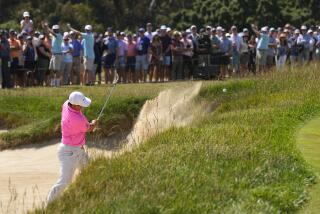Driver’s Training
AUGUSTA, Ga. — If he were to walk across that small, stone bridge that crosses Rae’s Creek as it hugs the left side of the 13th fairway at Augusta National, bends gently toward the sloping green, then swoops in front of it, Bobby Jones might notice the army of azalea bushes. If he were to take time to count, he would find nearly 1,600 of them. Maybe Jones would stop for a moment to admire them, then play on, probably checking his lie and hoping to reach the green in two.
The late Bobby Jones was born 100 years ago today, and Augusta National, the golf course he made into one of the most famous in the world, is nearing a special date of its own. In four weeks, just in time for the 66th Masters tournament, the most sweeping and dramatic changes that Augusta National has ever seen will be revealed to the public.
What would Bobby Jones say?
“I think he would say, ‘Well, this is today’s golf, they’ve kept up with the times,’” said Tom Fazio, the course designer who took the lead on the changes. “He would say, ‘It’s logical.’ All Augusta National is doing is trying to protect the integrity of their facility.”
And change is nothing new to the course, said Hootie Johnson, chairman of Augusta National.
“Beginning in 1934 and throughout their tenures [as chairmen], Cliff Roberts and Bob Jones made improvements to complement the changing state of the game,” Johnson said. “We have continued this philosophy. I think [in] the changes we have made, we have attempted to keep the golf course contemporary with the game of golf today.”
One thing is sure, it’s not the same old Augusta National. Said Larry Mize, the 1987 Masters champion, “On some holes, I don’t know if I’m even going to be able to see the green after I hit my tee shot.”
There’s some good news for Mize. On most of them, he will.
Fazio directed a group of four contractors working together on the project that began June 2, supported by as many as 15 subcontractors and, on an average day, 156 workers. The work was completed Oct. 5.
Nine holes were altered, the course was lengthened by nearly 300 yards, bunkers were beefed up, landing areas were shaved, trees were planted, tee boxes were shifted and now, there will be a whole new way of doing business. Or at least that’s what Johnson and the board of directors are hoping for.
Take the 18th hole, for instance. It’s gone from 405 yards to 460, still mostly uphill, with the bunkers on the left 10% bigger. It’s 300 yards to the first bunker, 335 yards to carry both of them. The fairway has been flattened a little to create a landing area, 285 yards from the tee, which is supposed to be the way to go.
But there’s more. There are seven new pine trees to the left of the bunkers to discourage the adventurous from going too far that way, and the green has been expanded slightly, recovering some lost edges and establishing a pin placement at the back right, just over another yawning bunker.
The old 18th hole? That driver-and-sand-wedge that Tiger Woods used last year to close out his second Masters title is gone forever.
What has happened here is nothing less than the most ambitious golf course makeover of all time--with an accompanying burden of responsibility for history.
The players will be the ultimate critics when the Masters begins April 11, but Johnson is prepared for the scrutiny.
“We are very pleased with the course,” he said. “Along with the rest of the Augusta National people, we feel comfortable with all the changes in recent years. We’ve made the right decisions. We try to think out things carefully. We don’t do anything hasty at Augusta National.”
There has been a parade of pros showing up to play the new course, among them Woods, Greg Norman, Jack Nicklaus, Arnold Palmer, Mark Calcavecchia, Mark O’Meara, Raymond Floyd, Ernie Els, Billy Andrade, Tom Pernice, Vijay Singh and Tommie Aaron.
“It’s going to be a driver’s golf course,” Els said. “It is a long hitter’s dream. You have to hit your driver a long way to attack the par fives and some of the par fours. Like the first and 18th, you will be hitting in mid-irons rather than wedges.”
When Singh played recently, he hit a three-iron second shot onto the 18th green.
Johnson said the consensus among the players is that the alterations look as if they have been around for years.
Work was done on seven of the 10 par-four holes and two of the par fives. Woods said that the redone hole that really got his attention was No. 7, which was lengthened by 45 yards to 410, with the tee area framed by tall trees on either side. Nothing was done to the greenside bunkers, which are numerous and tough enough anyway.
Said Woods, “The fairway is narrowed up quite a bit because all of a sudden, you can’t hit a two-iron off that tee anymore because you’re going to be a hitting a five-iron or six-iron. [If] you drive it down there, it narrows up quite a bit. And the fairway pitches from left to right, so it’s quite a big change.”
Woods used a driver there on Sunday last year and had only 45 yards to the flag. The feeling now is that most players are going to have to hit a driver because of its added length.
Woods says he has no problem with the changes, which Johnson announced the day before Woods began his successful run to a second Masters title.
“I think the changes they have made, as Hootie has tried to explain to me, they are trying to get the golf course back to how they used to play it,” Woods said. “Which is all right. Hitting longer clubs into greens.
“What they have tried to do more than anything is to bring driving back into the game at Augusta. Before, you could just bomb and not pay attention to where you hit it. It would help if you put the ball on certain sides between galleries to give yourself a better angle into the flag but, realistically, you could hit the ball anywhere and go find it. Now you have to drive the ball in play to shoot a good number.
“Hootie has explained to me that driving is an integral part [and] at Augusta, that hasn’t always been the case. You have to drive the ball ... really hit it solid and straight. You are going to really have to have that in order to compete there.”
The new Augusta National wastes no time introducing itself. The first tee, which used to be about even with the huge tree at the back of the clubhouse, has been moved back 25 yards. That meant the putting green had to be moved back as well. The fairway bunker on the right, which wasn’t in play before, returns to action in a big way. It has also been extended 15 yards toward the green. To carry the bunker requires a 300-yard drive. Some of the landing area has been flattened so it doesn’t look so uphill anymore, but it’s still a hike. The hole measures 435 yards.
At No. 8, the big news--besides the tee being moved back 20 yards and 10 yards to the right--is that the bunker on the right has been doubled in size. It’s 305 yards to carry the bunker now. The problem is, you don’t want to be too far left because that’s the hardest approach to the flag.
The theory on the ninth hole always was to bomb it as far as you could down the right side and let it roll down the hill toward the crosswalk, then just pitch it on the green. Some new trees have been planted on the right side at the bottom of the hill and pine needles scattered. Slinging it right and letting it roll harmlessly into the first cut is a thing of the past. The hole is 30 yards longer to 460.
The tees at the downhill 10th are 10 yards back, making the hole 495 yards, and five yards to the left, asking more of a right-to-left shot.
One of the more dramatic changes is at the 11th, which has a new tee box ringed by new magnolia trees, 35 yards farther back than previously and five yards to the right. It’s a 490-yard hole now and Woods is probably going to hit a driver, just as he did last year. Shorter hitters will find a flattened landing area, which will help them, but longer hitters, like Woods, aren’t going to have the sloping fairway they used to bounce their shots off, watching them roll toward the hole. It has been flattened. Second shots to the green are going to call for longer irons than in years.
The 13th tee box is a new area of the course, acquired from neighboring Augusta Country Club, about 25 yards behind the old tees. It’s a 510-yard hole now, requiring players to hit their drives around the corner on the dogleg left to give them a chance to go for the green in two.
The 14th is more difficult, lengthened 35 yards to 440, but with the fairway rolling left to right, you can’t miss it right in the trees. And with longer irons required to reach the green, it’s going to be an adventure keeping the ball on the green.
The official yardage at Augusta National is now 7,270 yards, with four of the par fours measuring at least 460 yards and all of the par fives at least 500. The official numbers are sure to take on more importance when the players drive up Magnolia Lane and take their first looks at the makeover. Woods has been popularly designated the prime beneficiary of the changes because of his distance off the tee, but his advantage remains to be seen.
According to Palmer, that’s the beauty of the changes.
“I do not think that new distances will make any differences,” he said. “It’s going to make the course a little more challenging, but one thing about Augusta is that even though they’ve added distance, you still have to hit the shots to the green.”
Right. It’s just that getting there may be much different journey than ever before.
*
(BEGIN TEXT OF INFOBOX)
Augusta Changes
A look at what will be different for players at the Masters next month:
* No. 1: Tees moved back 25 yards. Reshaped fairway bunker, extending 15 yards toward the green, creating 300-yard carry. Portion of fairway landing area regraded. Length increases from 410 yards to 435 yards.
* No. 7: Tees moved back 40-45 yards. Portion of fairway landing area regraded. Length increases from 365 yards to 410 yards.
* No. 8: Tees moved back 20 yards and shifted to the golfer’s right 10 yards. Fairway bunker reshaped and nearly doubled in size, creating carry of about 305 yards. Length increases from 550 yards to 570 yards.
* No. 9: Tees moved back 25-30 yards. Length increases from 430 yards to 460 yards.
* No. 10: Tees moved back 5-10 yards and five yards to golfer’s left. Length increases from 485 yards to 495 yards.
* No. 11: Tees moved back 30-35 yards and five yards to golfer’s right. Portion of fairway landing area regraded. Length increases from 455 yards to 490 yards.
* No. 13: Tees moved back 20-25 yards. Length increases from 485 yards to 510 yards.
* No. 14: Tees moved back 30-35 yards. Length increases from 405 yards to 440 yards.
* No. 18: Tees moved back 55-60 yards and five yards to golfer’s right. Bunker complex adjusted by making bunkers approximately 10% larger, with carry of about 335 yards. Trees added left of fairway bunkers. Green regrassed and expanded to recover lost edges. Possible new pin position right rear of green. Length increases from 405 yards to 460 yards.
*
Source: Associated Press
More to Read
Go beyond the scoreboard
Get the latest on L.A.'s teams in the daily Sports Report newsletter.
You may occasionally receive promotional content from the Los Angeles Times.










